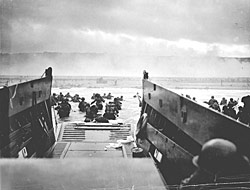
Unit 5: Crisis and Change
Lesson G: Theaters and Consequences of World War II
Lesson Overview
World War II was the most extensive war ever fought, and it extended to all of the major seas and the continents of Africa, Asia, and Europe. The focus of the previous lesson was on the early years of the war (1939-1943); this lesson focuses on the remaining years of the war and the aftermath of World War II.
By 1943, after a series of German defeats in Eastern Europe and U.S. victories in the Pacific, the Axis Powers lost their advantage. The war eventually ended with the separate Allied victories over Germany and Japan, both in 1945.
World War II altered the political alignment and social structure of the world. Economically, many countries were hard-hit by the destruction of war and concentrated on trying to rebuild their industries and economies. Imperialistic countries felt the changes as the countries in Asia and Africa, who had also actively participated in the fighting, worked for decolonization. The United Nations was established to prevent future conflicts. The United States and the U.S.S.R. emerged as rival superpowers, with the tensions between them beginning an era known as the Cold War.
Key Questions
- Why do countries go to war?
- How have wars impacted world science and culture?
- How should evidence support a historical argument?
- Why did the conflicts and crises of the first half of the 20th century become global in nature?
- How did the conflicts and crises of the first half of the 20th century impact the world?
Student Outcomes
- Explain the consequences of World War II, including the physical and economic destruction of land and property and the enormous loss of life.
- Describe the devastation suffered by Jews and other groups during the course of the Nazi Holocaust.
- Analyze the atrocities committed against civilians during World War II, including the Holocaust in Europe and the Rape of Nanking in China.
- Compare World War I and World War II in terms of the impact of industrial productions, political goods, national mobilization, technological innovations, and scientific research on strategies, tactics, and levels of destruction.
- Explain how the United Nations was established to prevent future conflicts and address issues of global concern.
- Explain the reasons for the dropping of atomic bombs on Japan and its short- and long-term effects.
- Explain the major turning points of the war, and describe the principal theatres of conflict in Western Europe, Eastern Europe, the Soviet Union, North Africa, Asia, and the Pacific.
- Assess how the political and diplomatic leadership of such individuals as Churchill, Roosevelt, Hitler, Mussolini, and Stalin affected the outcome of the war.
- Compare the impact of World War II on women and civilians in countries such as the United States, Great Britain, and the Soviet Union.
- Obtain historical data from a variety of sources. (Historical Thinking Skill)
- Support interpretations with historical evidence. (Historical Thinking Skill)
Key Terms
Student Resources
- World War II Timeline Graphic Organizer (doc)
- African Opposition to Colonialism (pdf)
- MAIN in Africa (doc)
- Libyan Independence Case Study (pdf)
- Historical Investigation - Genocide (doc)
Chart of Activities
| Activities to Complete | Estimated Time |
|---|---|
| Pre-Assessment | 10 minutes |
| Key Terms | 5 minutes |
| Activator: The World - 1939 - 1945 | 5 minutes |
| Opening: Overview of World War II | 5 minutes |
| Activity 1: Faces of World War II | 10 minutes |
| Activity 2: Theatres of War and the Beginning of the End | 15 minutes |
| Activity 3: Actions of the Leaders of World War II 1943-1945 | 15 minutes |
| Activity 4: Total War: Technological Innovations | 20 minutes |
| Activity 5: Civilian Impact | 20 minutes |
| Activity 6: And Interconnected World - Post-War Division and the United Nations | 15 minutes |
| Activity 7: Independence for African Colonies After World War II - A Case Study | 15 minutes |
| Review and Assessment | 60 minutes |
| Lesson Summary | 5 minutes |
Lesson Completion Time
The total estimated time to complete this lesson is 230 minutes.
Page Notes:
[1] Source: This image from http://en.wikipedia.org/wiki/File:1944_NormandyLST.jpg is in the public domain.



